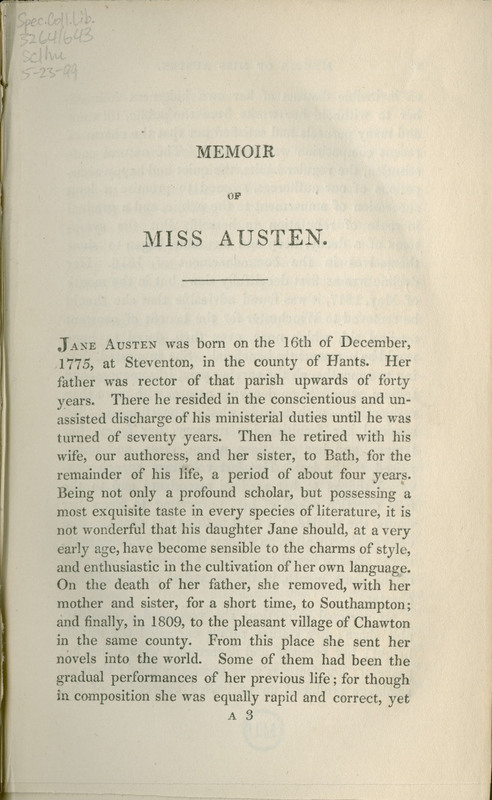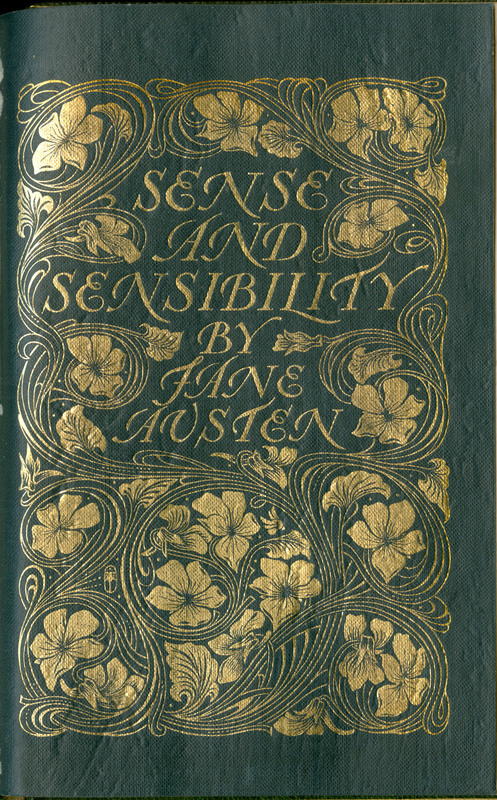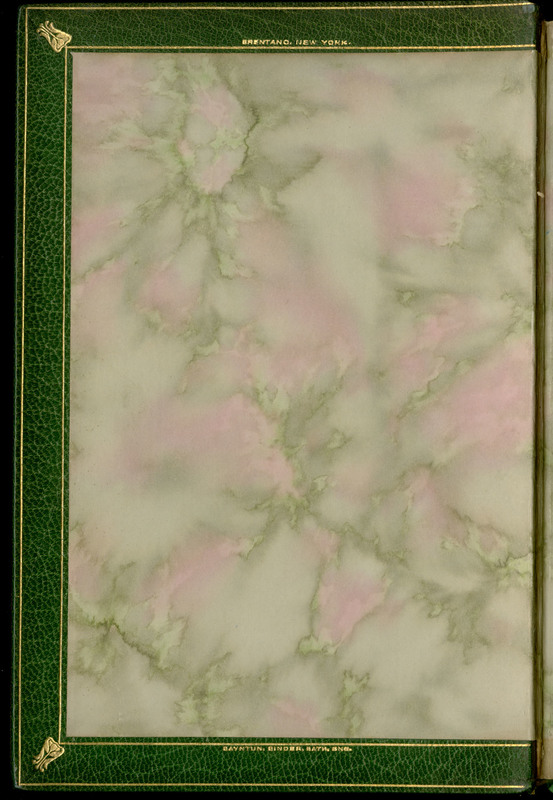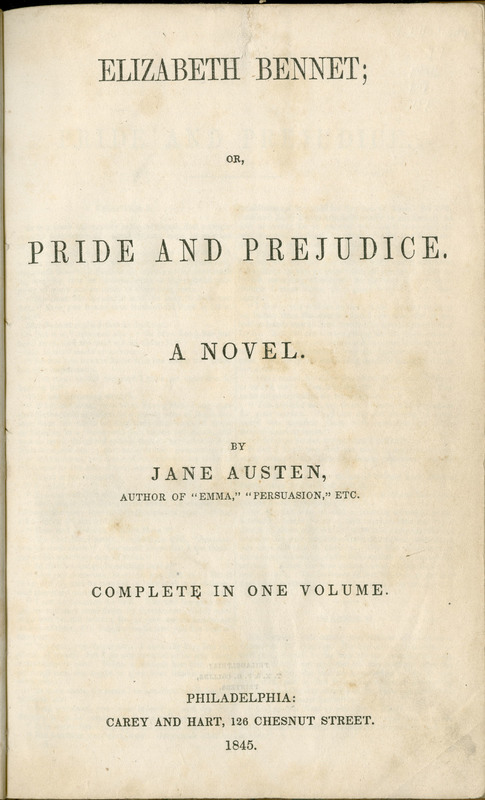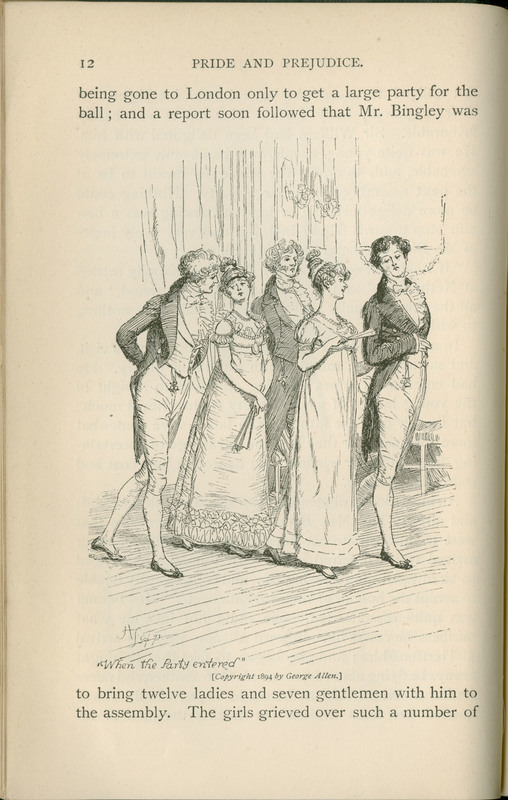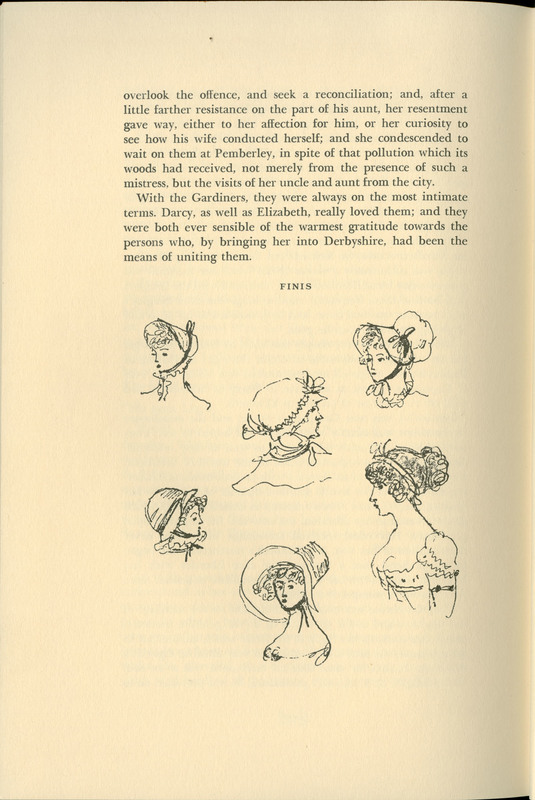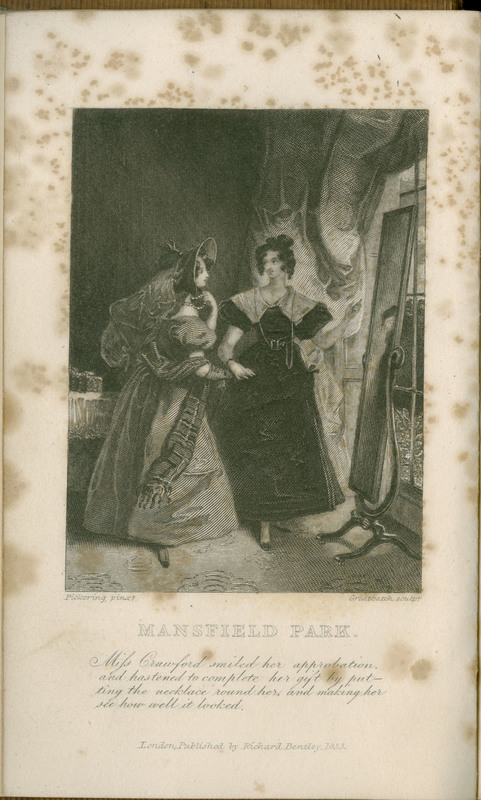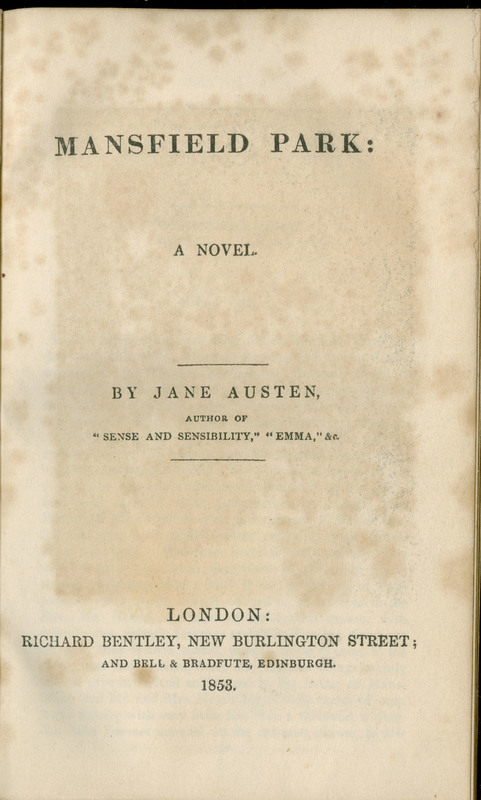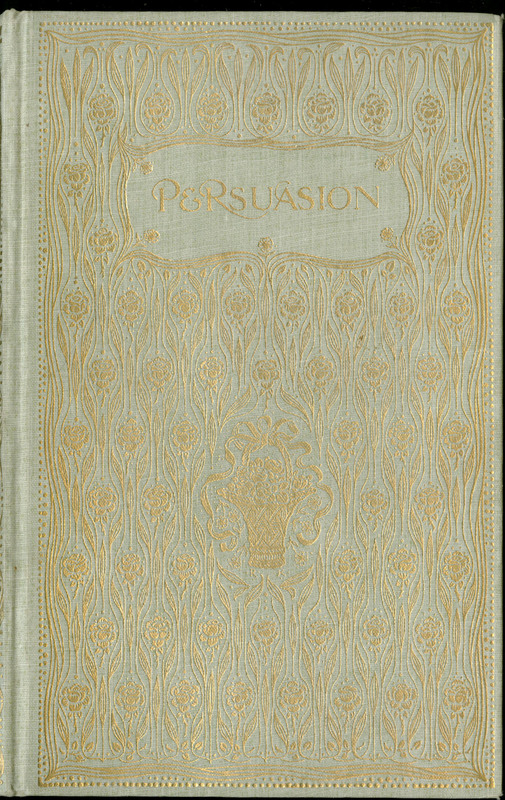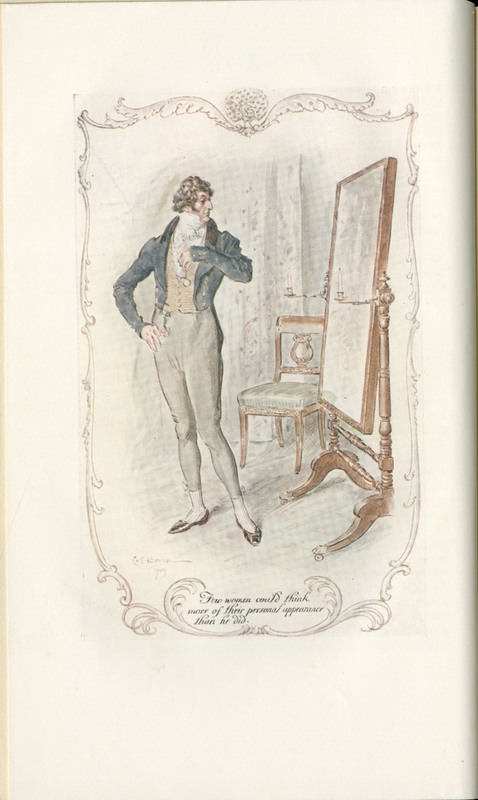Spotlight on Austen's Novels
Austen’s fiction has been almost continuously in print, on both sides of the Atlantic, since the time of her death. The items in this section of the exhibit highlight the ways in which different nineteenth and twentieth-century editions of her novels speak volumes (pun intended) about changes in publishing history, book purchasing power and literacy rates as well as changing audiences for--and interpretations of--Austen’s fiction.
Sense and Sensibility
Bound in publisher's cloth and neatly printed, this 1846 edition of Sense and Sensibility has two unusual features: the fact that its introduction is an un-attributed “memoir” of Jane Austen’s life, and its publication of all three volumes of the novel in one volume.
The memoir was written in 1818 by Henry Austen, Jane’s favorite brother, but wasn’t published with an attribution until 1870. While this memoir was not specifically written for Bentley’s Sense and Sensibility, it highlights details of Jane Austen’s life that may have inspired her writing the novel, such as the untimely death of the author’s father and her family’s subsequent, forced change of residency. It provides the reader with the resources to interpret, making it a significant addition to the novel.
This edition of Sense and Sensibility also contains all three volumes, which is rare, as novels were traditionally sold separated by volume due to cost and printing factors. The price of one three-volume novel was equivalent to half the weekly income of a modest, middle-class household in the 1840s. Because of this expense, three-volume novels were sold mainly to private circulating libraries, where many families could access them. It is likely, then, that this very edition was once part of a library collection. This contrasts with novels of today, which are all generally published and sold as a singular entity. This transition demonstrates the rich transmission history of the novel and how its form has changed.
(Katelyn Carroll, Melina Glusac)
In the first four decades of the nineteenth century, reading was considered an elite privilege. However, beginning in the second half of the century, Victorian advocates who hoped to advance English society initiated a general push for expanding education and literacy. This granted lower classes more opportunities for reading. One reaction to this expansion of literacy, designed to reaffirm the cultural distinctions among different social classes, was the introduction of expensive, lavishly-bound books designed to appeal to only upper class book buyers. As certain books became more extravagant, they were often valued as much for appearance as for their content. Concentrating on the rarity and appearance of books, members of the elite augmented the divide between classes through the types of books they used and collected.
The re-binding of a book to make it increasingly ornate and fashionable is reflected in this 1899 version of Sense and Sensibility. This book is a deluxe and intensified version of the original. It includes, at the end of the re-binded book, the original spine and cover. Under the marbled paper on the interior of the cover, the words “Bayntun, Binder, Bath, Eng.” are stamped into the green leather. George Bayntun created a booming book-binding business in the early twentieth century. His company still thrives today under the motto: “fine bindings and rare books.”
(Eden Baniel, Hannah Ellis
Pride and Prejudice
This well-loved 1845 edition of Pride and Prejudice was published by Carey and Hart, a publishing company based in Philadelphia that reprinted many foreign works such as this one and many of Austen’s other novels, but also specialized in the publication of regional writing and frontier humor. This edition’s double columns of text and the altered title of Elizabeth Bennet; or, Pride and Prejudice are meant to mirror the formatting of the first American edition, which was published in 1832 by Carey and Lea, a predecessor to Carey and Hart Publishing. In the 1800s there were no overseas copyright laws, so American publishers like Carey and Hart had free reign to pirate British novels. This edition is made from inexpensive paper and materials, and the font is small and cramped in order to conserve paper and costs of production. In addition, the usual three volumes are compressed into one volume to make the novel even cheaper to produce and acquire. These publishing decisions demonstrate the popularity of Pride and Prejudice, especially since this isn’t the first American edition to be printed. The cheaper materials used suggest a cheaper selling price, making the novel more accessible to a wide audience of Jane Austen enthusiasts in America.
(Chloe Alberta, Karissa Knapp)
In reaction to the wave of British nationalism in the late nineteenth century, a renowned publisher of the time, George Allen, sought to preserve traditional English values by publishing a series of illustrated classic works of literature. His most successful was the “Peacock” edition of Pride and Prejudice, published in 1895. The edition’s iconic features include its gilded peacock cover (symbolic of pride) and 65 full page illustrations, all created by Hugh Thomson. As an acclaimed illustrator of the time, Thomson’s work symbolized grace and refinement, which made him the perfect choice for capturing Allen’s vision. His illustrations fundamentally changed the way that people read the novel by distracting readers from Austen’s satire, and instead directing readers’ focus on her faithful depiction of traditional English values and manners, which Allen hoped to promote. Another motivation of Allen's in publishing the novel was to revive Jane Austen’s legacy, which was threatened by fading popularity amidst changing literary styles. The edition surpassed expectations, selling over 11,605 copies in England and 3,500 copies in the United States, within the first year. Its popularity was partly due to its large appeal across class divisions, gender spheres, and political factions, functioning most basically as a gift book and mark of good taste. George Allen’s revival has proven to be timeless. Thomson’s peacock design has become the iconic representation of Austen’s Pride and Prejudice in contemporary marketing and merchandising, continuing to capture audiences today.
(Jennifer Miller, Audrey Rasch, Anne-Marie Varga)
The significance of this rare late twentieth-century edition of Pride and Prejudice cannot be mistaken. Only 750 copies of this edition were printed. It derives its name from the town of Godmersham, a village in the Ashford District of Kent, England. Pride and Prejudice is notable as the book that was based primarily on Austen’s experiences at her brother’s estate there. The images in this special edition of Pride and Prejudice are exclusive to this edition. This image illustrates the Bennet girls in their various states of dress, a comical image to those familiar with the story.
The edition also features an introduction by one of Austen’s grand nephews detailing the impact the Godmersham estate had on her life. Her brother, Edward was raised by another family in Godmersham and she frequently visited him and his wife to take care of their children. However, it also appears to have been an enjoyable source of inspiration as well. Austen observed and found great pleasure in detailing her day-to-day life there back to her family. Godmersham served as a backdrop for Pride and Prejudice: its stately homes fit a man of Darcy’s nobility. Even today, Godmersham is the home of many magnificent gardens and houses, which stand as tourist attractions. Taking a trip to Godmersham is likely to take one back in time, to the days of high tea and leisurely activities. In fact, Godmersham has hosted scholarly Austen conferences focusing on her life and literary work in recent years. The Godmersham Park Heritage Center boasts an impressive amount of information for anyone interested in visiting the area.
(Elizabeth Baker, Aaron Love)
Mansfield Park
Mansfield Park was originally published in 1814 as a single novel. Sixteen years after Austen's death in 1817, her brother and sister, Cassandra and Henry Austen, negotiated the reissue of her novels with publisher Richard Bentley. He purchased the copyright for Austen’s six novels and reprinted them as a set in five volumes as a part of his Standard Novels series in 1833. Each of these volumes had both a frontispiece and vignette title page that were created from engravings via steel plates. This 1853 edition, however, only has the original frontispiece, excluding the engraving on the title page.
Starting in the 1830s, Mansfield Park was regarded as one of Austen’s best novels, reaching the height of its popularity in the mid-nineteenth century. Its themes of religion and social morality connected with Victorian readership. That said, Mansfield Park’s heroine, Fanny Price, has tended to be a divisive character. At publication, Austen’s mother found Fanny to be “insipid,” while her brother, Frank, described Fanny as “delightful.” Many Victorians celebrated Fanny’s “delicacy, modesty, fortitude, and self-sacrifice.” This view echoed Coventry Patmore’s “The Angel in the House,” an 1854 poem that celebrated docile and complacent females as the Victorian ideal. Still, readership remained divided and others found Fanny to be “less of a favorite.” Mid-twentieth century scholars remained critical of Fanny, particularly within the field of feminist scholarship. However, Austen’s dramatic rise in popularity beginning in the 1980s has brought renewed interest to Mansfield Park and its heroine, Fanny Price.
(Cari Griffin, Madeleine Schneider)
Persuasion
This edition of Persuasion comes from the elegant “English Idylls” collection of Austen’s works published by the famous turn-of-the-century publishing house of J.M. Dent. For this series, Dent commissioned his long-time illustrator Charles E. Brock to create over twenty new, delicate watercolor illustrations for each novel. Brock’s illustrations recreate the attire for men and women during that time.
Persuasion was Jane Austen’s final novel before she passed away in 1817. We can see how mature and experienced Austen was at the time of writing this novel, due to the sophistication of the character development, as well as the eloquent and conscious use of character space. In Persuasion, Austen utilizes a narrative style which provides a unique view of the emotional, psychological and gendered social use of space in the early nineteenth century. Jane Austen uses Persuasion as a commentary about social change through narrative description, as well as psychological landscape. In this last novel, Austen presents the revolutionary idea that it is the individual who holds the tools necessary to advance in society; social class, gender, and family-ties were no longer the lone arbiters of social advancement.
(Antonio Gallegos, Alexis Gonzalez)

Jane Austen (1775-1817)
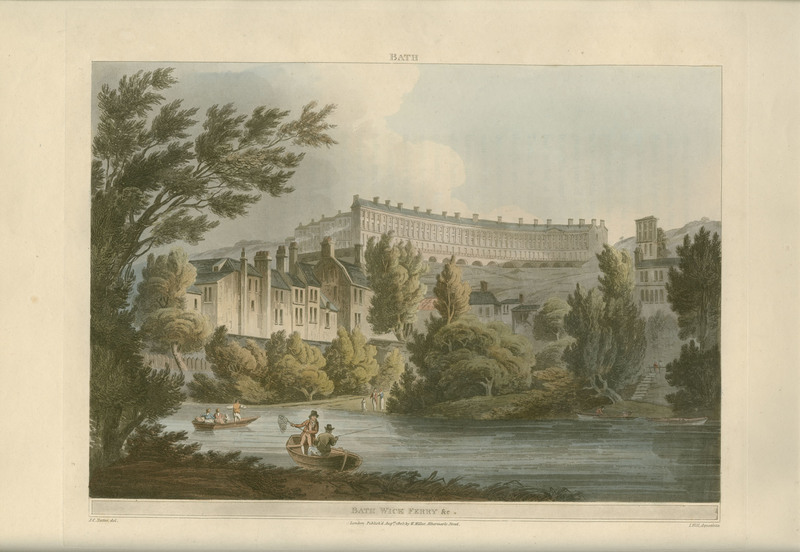
Exploring Georgian England


